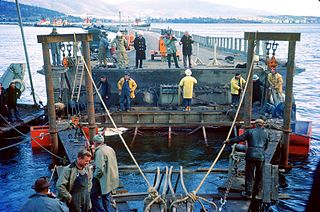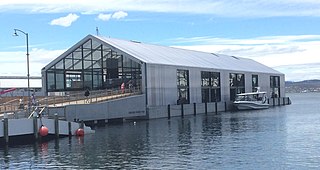Related Research Articles

An oil platform, oil rig, offshore platform, or oil and/or gas production platform is a large structure with facilities to extract, and process petroleum and natural gas that lie in rock formations beneath the seabed. Many oil platforms will also contain facilities to accommodate their workforce, although it is also common for there to be a separate accommodation platform bridge linked to the production platform. Most commonly, oil platforms engage in activities on the continental shelf, though they can also be used in lakes, inshore waters, and inland seas. Depending on the circumstances, the platform may be fixed to the ocean floor, consist of an artificial island, or float. In some arrangements the main facility may have storage facilities for the processed oil. Remote subsea wells may also be connected to a platform by flow lines and by umbilical connections. These sub-sea solutions may consist of one or more subsea wells or of one or more manifold centres for multiple wells.

A dry dock is a narrow basin or vessel that can be flooded to allow a load to be floated in, then drained to allow that load to come to rest on a dry platform. Dry docks are used for the construction, maintenance, and repair of ships, boats, and other watercraft.

Mulberry harbours were temporary portable harbours developed by the United Kingdom during the Second World War to facilitate the rapid offloading of cargo onto beaches during the Allied invasion of Normandy in June 1944. After the Allies successfully held beachheads following D-Day, two prefabricated harbours were taken in sections across the English Channel from the UK with the invading army and assembled off Omaha Beach and Gold Beach.

A caravan, travel trailer, camper, tourer or camper trailer is a trailer towed behind a road vehicle to provide a place to sleep which is more comfortable and protected than a tent. It provides the means for people to have their own home on a journey or a vacation, without relying on a motel or hotel, and enables them to stay in places where none is available. However, in some countries campers are restricted to designated sites for which fees are payable.

Dredging is the excavation of material from a water environment. Possible reasons for dredging include improving existing water features; reshaping land and water features to alter drainage, navigability, and commercial use; constructing dams, dikes, and other controls for streams and shorelines; and recovering valuable mineral deposits or marine life having commercial value. In all but a few situations the excavation is undertaken by a specialist floating plant, known as a dredger.

The Hobart Bridge was a floating arch bridge that crossed the River Derwent, connecting the eastern and western shores of the city of Hobart, Tasmania, Australia.

Garden Island is an inner-city locality of Sydney, Australia, and the location of a major Royal Australian Navy (RAN) base. It is located to the north-east of the Sydney central business district and juts out into Port Jackson, immediately to the north of the suburb of Potts Point. Used for government and naval purposes since the earliest days of the colony of Sydney, it was originally a completely-detached island but was joined to the Potts Point shoreline by major land reclamation work during World War II.

Sullivans Cove is on the River Derwent adjacent to the Hobart City Centre in Tasmania. It was the site of initial European settlement in the area, and the location of the earlier components of the Port of Hobart.

Incat Tasmania is an Australian manufacturer of high-speed craft (HSC) catamaran ferries. Its greatest success has been with large, sea going passenger and vehicle ferries, but it has also built military transports and since 2015 it has built smaller river and bay ferries. Based in Derwent Park, a suburb of Hobart, Tasmania, Australia, it was founded by Bob Clifford.

Granite Island, also known by the Ramindjeri people as Nulcoowarra, is a small island next to Victor Harbor, South Australia, about 80 km south of South Australia's capital city, Adelaide.

USS Halyburton (FFG-40), an Oliver Hazard Perry-class frigate, is a ship of the United States Navy named for Pharmacist's Mate Second Class William D. Halyburton, Jr. (1924–1945). Halyburton was posthumously awarded the Medal of Honor for his heroism while serving with the 5th Marines, during the Battle of Okinawa in 1945.

Tubing, also known as inner tubing, bumper tubing, towed tubing, or kite tubing, is a recreational activity where an individual rides on top of an inner tube, either on water, snow, or through the air. The tubes themselves are also known as "donuts" or "biscuits" due to their shape.

R/P FLIP is an open ocean research platform owned by the U.S. Office of Naval Research (ONR) and operated by Scripps Institution of Oceanography. The platform is 108 meters (355 ft) long and is designed to partially flood and pitch backward 90°, resulting in only the front 17 meters (55 ft) of the platform pointing up out of the water, with bulkheads becoming decks. When flipped, most of the ballast for the platform is provided by water at depths below the influence of surface waves, hence FLIP is stable and mostly immune to wave action similar to a spar buoy. At the end of a mission, compressed air is pumped into the ballast tanks in the flooded section and the platform, which has no propulsion, returns to its horizontal position so it can be towed to a new location. The platform is frequently mistaken for a capsized ocean transport ship.

Middleton Beach is a coastal suburb of Albany, Western Australia, located within the City of Albany approximately 4 kilometres (2.5 mi) east of the city centre. The traditional owners, the Noongar peoples, know the place as Binalup meaning the place of first light since the sun rises over the waters in the morning. The main road between the city and the locality is via Middleton Road. It is home to a caravan park and numerous holiday units which provide accommodation for visitors to the Albany region.

Floating nuclear power stations are vessels designed by Rosatom, the Russian state-owned nuclear energy corporation. They are self-contained, low-capacity, floating nuclear power plants. Rosatom plans to mass-produce the stations at shipbuilding facilities and then tow them to ports near locations that require electricity.

MH-1A was the first floating nuclear power station. Named Sturgis after General Samuel D. Sturgis, Jr., this pressurized water reactor built in a converted Liberty ship was part of a series of reactors in the US Army Nuclear Power Program, which aimed to develop small nuclear reactors to generate electrical and space-heating energy primarily at remote, relatively inaccessible sites. Its designation stood for mobile, high power. After its first criticality in 1967, MH-1A was towed to the Panama Canal Zone that it supplied with 10 MW of electricity. Its dismantling began in 2014 and was completed in March 2019.

A floating wind turbine is an offshore wind turbine mounted on a floating structure that allows the turbine to generate electricity in water depths where fixed-foundation turbines are not feasible. Floating wind farms have the potential to significantly increase the sea area available for offshore wind farms, especially in countries with limited shallow waters, such as Japan, France and US West coast. Locating wind farms further offshore can also reduce visual pollution, provide better accommodation for fishing and shipping lanes, and reach stronger and more consistent winds.
Memory Cove Wilderness Protection Area is a protected area in the Australian state of South Australia located on the south east tip of Jussieu Peninsula on Eyre Peninsula and on a number of nearby islands about 25 km (16 mi) south-south east of Port Lincoln. It was established in 2004 on land previously part of the Lincoln National Park. The protection area contains significant sites of natural, indigenous and early European heritage.
Nicolas Baudin Island Conservation Park is a protected area associated with Nicolas Baudin Island which is located off Cape Blanche on the west coast of Eyre Peninsula in South Australia about 30 kilometres south of Streaky Bay. The conservation park was proclaimed in 2003 under the National Parks and Wildlife Act 1972 to ‘protect a significant breeding location for the Australian sea lion.’

The Brooke Street Pier is a floating pontoon building at Sullivans Cove in the waterfront area of the city of Hobart, Tasmania, Australia. It was constructed in 2014–15 at a cost of A$13 million. It weighs 5,300 tonnes and was Australia's largest floating building upon completion. It is connected to the Hobart shore at Franklin Wharf, near the base of Brooke Street. Primarily a ferry terminal, the architect has described it as a "tourism transport hub".
References
- ↑ "Queensland Government - Housing and Public Works - Floating Building" (PDF). Retrieved 21 January 2015.
- ↑ Charles M. Trout (2002). Electrical Installation and Inspection. ISBN 0766820580 . Retrieved 21 January 2015.
- ↑ "Circa Morris Nunn – Brooke Street Pier" . Retrieved 21 January 2015.
- ↑ "Australia's biggest floating building is secured on Hobart's waterfront". Australian Broadcasting Corporation. 9 November 2014. Retrieved 21 January 2015.
- ↑ "Floating Vietnam nightspot languishes in North Korean port". Thanh Nien News. 29 September 2014. Retrieved 21 January 2015.